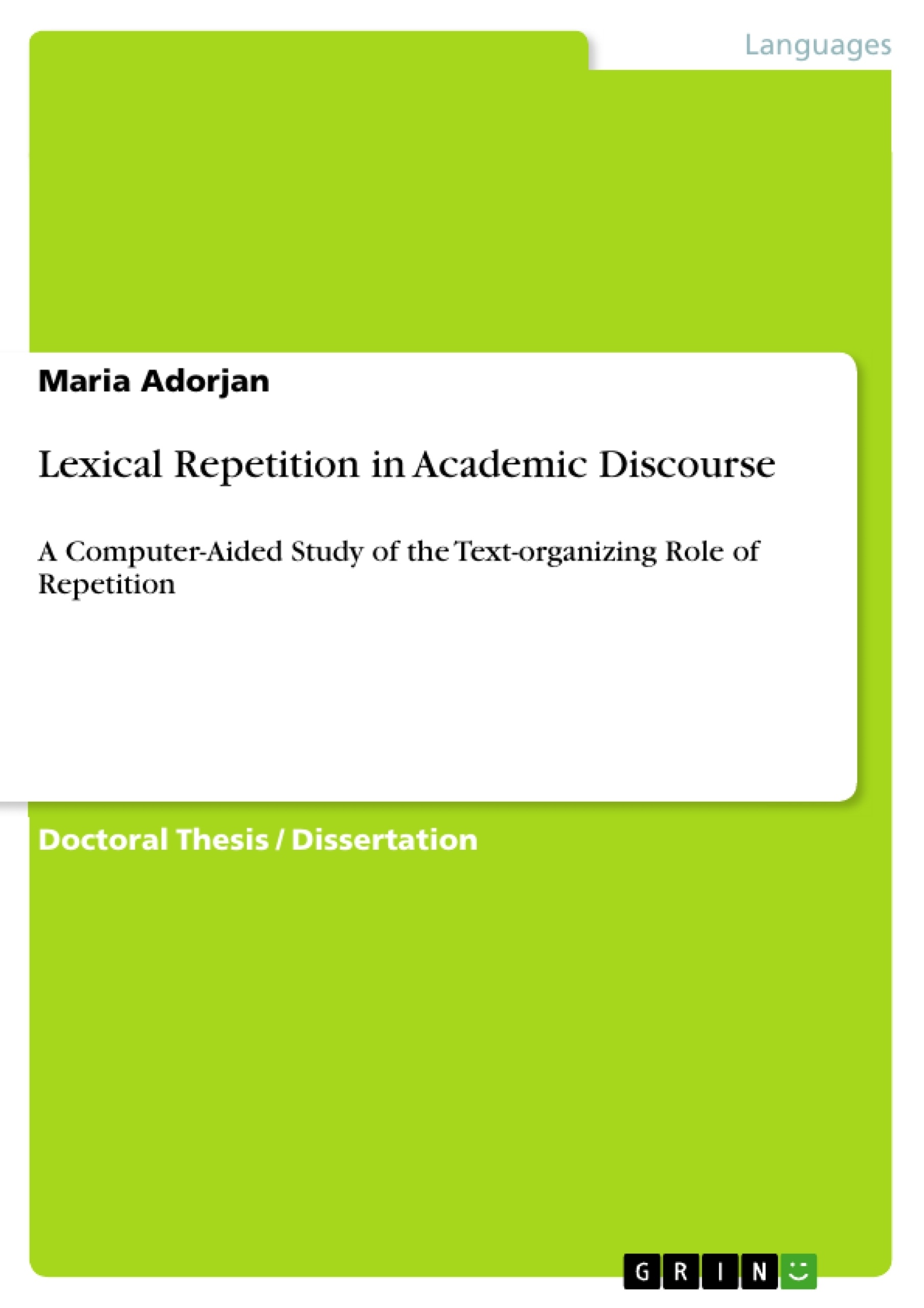Leseprobe
Table of Contents
1. Introduction.
1.1 Background to the study.
1.2 Aims of the present research.
1.3 An overview of the dissertation.
2 Theoretical Framework.
2.0 Overview.
2.1 Coherence and cohesion.
2.1.1 Definitions of coherence and cohesion
2.1.2 Types of cohesion
2.2 Lexical cohesion and lexical repetition.
2.2.1 Categories of lexical cohesion
2.2.2 Lexical chains or a lexical net?
2.3 Hoey’s (1991) Repetition Model 16
2.3.1 The theoretical background of the model
2.3.2 Hoey’s (1991) taxonomy of lexical repetition
2.3.3 Links and bonds creating a lexical net
2.3.4 The steps of the analysis
2.3.5 Applications of Hoey’s (1991) model
2.3.6 Inconsistencies within Hoey’s (1991) model
2.3.7 The link triangle and the mediator missing
2.3.8 The questions of anaphora resolution
2.3.9 Prescriptiveness or descriptiveness of the model
2.4 Károly’s (2002) Repetition Model 29
2.4.1 Károly’s (2002) taxonomy of lexical repetition
2.4.2 Károly’s (2002) method of analysis
2.4.3 Károly’s empirical investigation
2.4.4 A corpus-based investigation using Károly’s (2002) taxonomy. 332.5 .. Summary
3 Methodological background: the academic writing context.
3.0 Overview..
3.1 The nature of academic discourse.
3.1.1 General features of English academic discourse
3.1.2 The types of writing tasks required at university
3.1.3 Disciplinary differences in academic discourse
3.1.4 Implications for language pedagogy
3.1.5 Independent vs. integrative writing tasks
3.2 Task variables influencing academic discourse quality.
3.2.1 The classification of variables in academic writing
3.2.2 Contextual variables of integrated academic discourse quality
3.2.3 Cognitive variables of integrated academic discourse quality
3.2.4 Summary writing as a complex task
3.2.5 Writing a compare/contrast essay
3.3 Assessing academic discourse.
3.3.1 ‘Traditional’ and recent academic essay assessment practices
3.3.2 Validity in L2 academic writing assessment
3.3.3 Generalizability of judgement on academic discourse quality
3.3.4 Reliability of perceived discourse quality
3.3.5 Text quality requirements by course teachers
3.3.6 Explicit instruction on coherence, cohesion and lexical repetition in higher education
3.3.7 Automated assessment of text quality
3.3.8 Controversial views on the automated assessment of essay quality
3.4 Summary.
4 Aims and Research Questions.
5 Research design and procedures of analysis.
5.1 A sequential mixed design.
5.2 Stage 1: Analysis of academic summaries.
5.2.1 The summary writing task
5.2.2 Corpus size and representativity
5.2.3 Context validity evaluation of the summary writing task
5.2.4 Features of the input text
5.2.5 Quality assessment of the corpus
5.2.6 Methods of data analysis in Stage
5.3 Stage 2: Analysis of compare/contrast essays.
5.3.1 The compare/contrast essay writing task
5.3.2 Quality assessment of the corpus
5.3.3 Methods of data analysis in Stage
6 Results of the lexical repetition analysis of academic summaries.
6.1 General features of the summaries.
6.2 Results related to repetition type.
6.3 Results related to the combination of links and bonds.
6.4 Methodological outcomes.
6.5 Summary.
7 Results of the lexical repetition analysis of compare/contrast essays.
7.1 General features of the compare/contrast essays.
7.2 Results related to repetition type.
7.3 Results related to the combination of links and bonds.
7.4 Features not detected.
7.5 Methodological outcomes with automation in mind.
7.6 Summary.
8 The design of a new LRA model for large-scale analysis.
8.1 The newly proposed LRA model: the three modules of the analysis.
8.2 Phase 1: Preparation of the corpus. 125
8.2.1 Plagiarism check
8.2.2 L2 special corpora treatment / Error treatment
8.2.3 POS tagging
8.2.4 POS tagging for lower level L2 texts
8.2.5 Using WordNet with the existing taxonomy
8.2.6 Using WordNet with errors in a learner corpus
8.3 Phase 2: Finding links.
8.3.1 Theoretical considerations: altering the taxonomy
8.3.2 Introducing the concept of ‘key term’ into the coding process
8.3.3 Lexical unit identification in the case of multiword units
8.4 Special use of the model for academic summary writing.
8.5 Visual representation of links and bonds.
8.6 Connecting the new LRA model to a cognitive framework.
8.7 The scope and limitations of the new LRA model
9 Conclusions.
9.1 Summary of main results.
9.2 Pedagogical implications.
9.3 Limitations.
9.4 Terminology issues
9.5 Suggestions for further research.
References.
APPENDICES.
- Arbeit zitieren
- Dr Maria Adorjan (Autor:in), 2016, Lexical Repetition in Academic Discourse, München, GRIN Verlag, https://www.grin.com/document/459913
Kostenlos Autor werden






















Kommentare